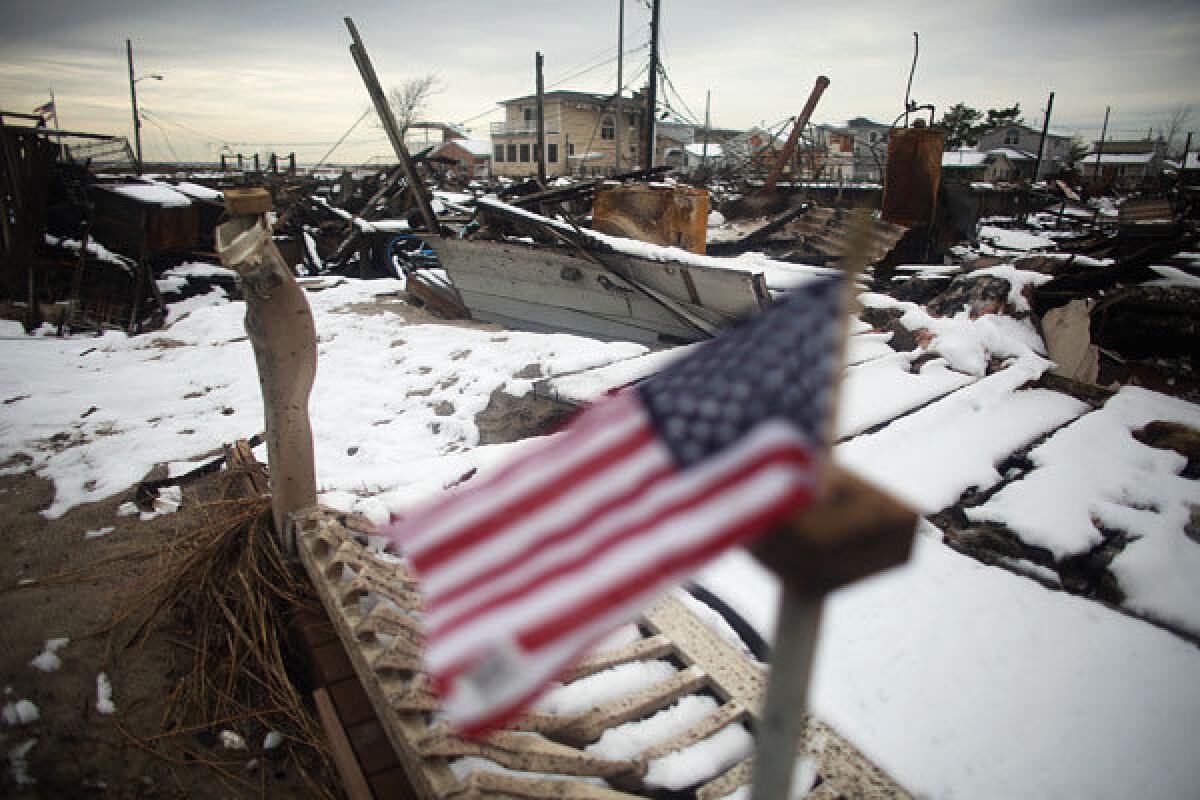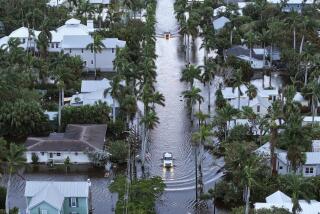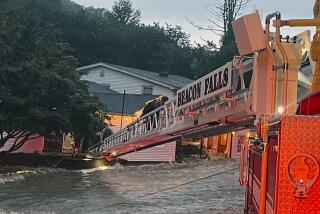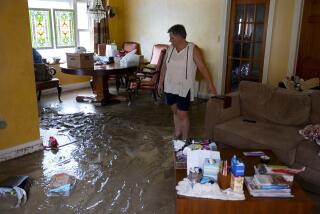Superstorm Sandy claims 43rd life in New York City

- Share via
NEW YORK -- The grim toll from Superstorm Sandy has risen yet again in New York City with the death of a 77-year-old man who was found at the bottom of the stairs inside his dark, beachfront apartment building on Halloween.
Police said Sunday that Albert McSwain was the 43rd confirmed storm-related death in the city. His apartment building, on a beachfront boulevard in the Rockaways section of Queens, lost power as the storm made landfall on Oct. 29.
McSwain was found with head and body trauma, paralyzed from the neck down, on Oct. 31. He died of his injuries Saturday at a Queens hospital, officials said.
Much of the Rockaways, a narrow peninsula surrounded by Jamaica Bay on one side and the ocean on the other, has been without electricity since the storm hit. More than 166,000 people in New York, New Jersey and West Virginia remain without power, with New York suffering the most extensive outages.
According to a U.S. Department of Energy update Sunday, 132,965 customers in New York state had no electricity, and 102,885 of those outages were blamed on a powerful storm that dumped snow across New York City on Nov. 7. In New Jersey, about 27,000 people were without power. West Virginia reported 5,718 outages.
Amid the ongoing havoc, there were more signs of recovery as a new workweek began Monday. For the first time since the storm surge caused by Sandy sent saltwater pouring through the vital tunnels linking the five New York City boroughs to each other and to neighboring areas, the Gov. Hugh L. Carey Tunnel -- formerly known as the Brooklyn-Battery Tunnel -- reopened to limited rush-hour bus service Monday.
The tunnel -- the nation’s longest under-river vehicular passage -- began accepting bus traffic at 6 a.m. in one lane. It was to close again at 10 a.m. and then reopen between 3 p.m. and 7 p.m. for bus traffic.
During closed times, workers will continue trying to repair damage from the flooding. Officials say about 43 million gallons of water poured into each of the tunnel’s two tubes, damaging electrical, lighting, communications, surveillance and ventilation systems.
“It was filled floor to ceiling for more than a mile with water and debris,” said the chairman of the city’s Metropolitan Transit Authority, Joseph Lhota. “No one has ever faced a challenge like this,” he said in describing the repair effort. There’s no timetable for the tunnel to be fully operational.
Limited train service between Manhattan and New Jersey also resumed early Monday, and New York Gov. Andrew Cuomo announced the resumption of more service on the Long Island Railroad, which links New York City to the suburbs of Long Island to the east. Ten of its 11 branches were to return to full weekday schedules early Monday.
In announcing McSwain’s death, police also released a detailed accounting of some of the rescues that took place at the height of the storm, as electrical transformers exploded and dumped live wires into fast-rising water that devastated several neighborhoods.
The water surge was so intense that it made even travel by boat nearly impossible as emergency crews tried to reach people who began clamoring for help after Sandy made landfall, officials said.
“Boats with and without powerful motors became useless and ineffective after some time due to the large debris, the strong current and depth of the water, and the small streets that were difficult to navigate,” said Sgt. Anthony Lisi of the Police Department’s Emergency Services Squad 5, which includes Staten Island.
“Additionally, live power lines were falling down into the water, making rescues extremely hazardous to first responders. So utilizing boats became extremely difficult to use due to the strong, rising currents of water and the live power lines sparking everywhere,” Lisi said.
On Staten Island alone, more than 1,100 water rescues took place during and immediately after Sandy. The borough suffered the most casualties of any in the city, losing 23 residents. Many rescue workers had to wade through waist-high water to reach people.
As conditions worsened, picking up everyone who needed to be ferried to safety became more difficult. Each time a rescue crew arrived to fetch someone who had called 911 for help, “another 10 families on the block who needed to be evacuated would ask for assistance as well,” Lisi said. “This happened throughout the night.”
Police vehicles became bogged down in water and mud. Roiling waters tossed one officer from a personal water craft he was using to reach victims, and some officers even roped themselves to trees to rescue a pregnant woman and child. Most of the more dramatic rescues took place on Staten Island, in neighborhoods that were ordered to evacuate before the storm. Most people, though, stayed.
“They ... cited that the forecasters had been wrong so many times before, and there had been so many false alarms, that they felt the same was happening with Hurricane Sandy,” Lisi said.
ALSO:
Indianapolis explosion kills two, destroys neighborhood
Afghan massacre: Police officer doubts single-killer theory
Kandahar shootings: Youngest victims recall night of horror
More to Read
Sign up for Essential California
The most important California stories and recommendations in your inbox every morning.
You may occasionally receive promotional content from the Los Angeles Times.











